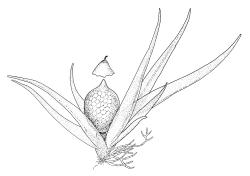- = Ephemerella Müll.Hal., Syn. Musc. Frond. 1, 34 (1848) nom. cons.
Plants minute, with abundant creeping and often lustrous protonema. Stems <0.5 mm, in cross-section lacking central strand. Leaves narrowly lanceolate or linear, acuminate, entire, toothed, or spinose; laminal cells lax and mostly thin-walled, rectangular below, ± rhomboidal above, smooth (in N.Z. material) or prorate. Costa variably developed, often absent.
Dioicous, pseudodioicous, or autoicous. Male plants bud-like, without paraphyses. Setae rudimentary or lacking; capsules cleistocarpous, mostly spherical or ellipsoid, with a small, solid apiculus, lacking neck; columella usually resorbed at maturity; exothecial cells thin-walled and lax; stomata superficial, 2-celled. Calyptra mitrate, enclosing only the capsule apex. Spores large, usually reniform, coarsely or finely papillose.
A moderate-sized genus widely distributed but with a preponderance of species in northern temperate regions. Thirty-two species were treated by Brotherus (1924). Stone (1996) recognised six species from Australia, with several of them occurring in western or tropical parts of that continent. Surprisingly, there appears to be no species overlap between Australia and N.Z., but several of the species treated by Stone do not occur in temperate parts of south-east Australia (where the greatest floristic similarity is expected). Six species (plus intraspecific taxa) were accepted for Europe by Holyoak (2010) and four species from eastern North America by Crum & Anderson (1981). Molecular phylogenetic studies may be required to demonstrate how closely allied the component species are.
| Category | Number |
|---|---|
| Exotic: Fully Naturalised | 2 |
| Total | 2 |




